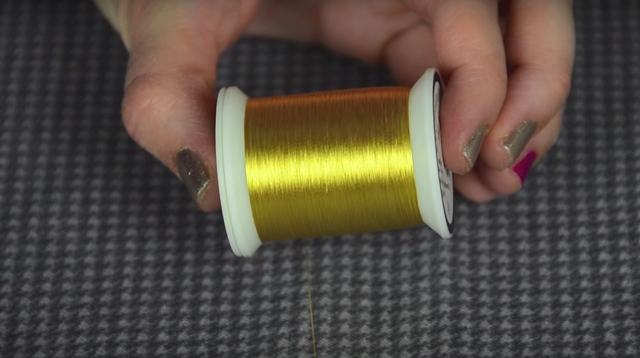Experimenting with novel materials and techniques helps to keep designs fresh and creative in custom embroidery digitizing. Specialty threads are used by embroiderers to enhance aesthetics of even the most ordinary designs. Whether it’s about adding a new dimension, adding bling or creating a special effect, specialty threads help us achieve these with minimal effort.
Although they reduce the effort to induce special effects, specialty threads do complicate the process. Extraordinary weight, or thickness or even the nature of material are just some of the reasons. To counteract, these necessary measures must be taken during custom embroidery digitizing and production phase. But without getting into that, let us get straight to the various specialty threads.
Traditional Metallic Thread:
Metallic thread is the king of specialty threads. It is the most widely known and used thread for creating special effects. While we all love seeing metallic embroidery designs, same is not the case with people who actually embroider them. It causes multiple issues and intricacies, and is, therefore, not the most preferred option for embroiderers.
The thread is made of polyester or nylon which is wrapped in metallic foil. Other materials are also added to achieve desired flexibility or texture. One of the primary concerns is its delicacy. Feeble nature of the metallic thread makes it difficult to work with. In most cases, it is the substandard manufacturing practices of metallic thread that is to blame.
Since embroiderers have little to no control over the quality, metallic thread is susceptible to damage from friction. Therefore, while working with metallic threads it is important to use large eye needles. If large eye needles are not readily available, you can also use larger blades to get larger needle eye. Moreover, use light tension settings. Reduce tension on the top thread as it will avoid frequent thread breakage. Additionally, you can also reduce machine speed.
Metallic threads come in different weights and thicknesses. Light threads are good for detailed areas while heavier threads are more suitable for covering large areas. Metallic nature renders increased stiffness in the thread. As a result, longer stitches are used during custom embroidery digitizing. Longer stitches make the sewing process smooth and swift. Due to the stiffness, metallic designs are covered with a soft fusible material from the back.
Flat Metallic Thread:
A less popular variant of the traditional type is the flat metallic thread. It has a ribbon-like appearance with a metallic bling. It has a flat and reflective surface that works with longer stitches. Not only the longer stitches, other digitizing settings that we discussed for the traditional type works equally well with this category as well. It is made up of a polyester film which is laminated in aluminum foil.
Bold Yarn Thread:
Completely opposed to glowing outlook, here are the bold and flat yarn like threads. These are especially useful for creating olde wordle and folk embroidery designs. Such embroidery designs have quite recently been really popular which further makes these threads imperative.
Like metallic, large eye needles are also essential here. During custom embroidery digitizing, lower the density as compared to the normal thread. Space stitches widely to achieve a traditional look. To achieve different effects you can play with the stitch density. Make sure that whatever value you choose while you are experimenting, it is less than the density used with the standard thread.
 Fine Thread:
Fine Thread:
Fine specialty threads are in complete contrast to the bold ones. Bold specialty threads provide more coverage for large areas. Therefore, they are suited for larger areas. On the contrary, finer threads are best suited for creating small embroidery.
One of the frequent use of it is in the small lettering. Small lettering is a painstaking task for most embroiderers. Creating clear and tidy small letters is a challenging task. Fine thread with a small needle is really useful in dealing with this challenge of coping with small lettering. Apart from this change, employ lighter density and fewer intersections during custom embroidery digitizing.
 Glowing Thread:
Glowing Thread:
The concept is exciting. Glowing thread glows in a dark environment and thus, creates room for creating interesting embroidery designs. It is primarily made of polyester, which stores light and emits it in dark to give the signature glow. While using it, use normal 75/11 needle. It is so because glowing threads normally come in the standard 40 size. If you are using extra-ordinarily tick or thin variants, you must make changes to embroidery machine needle size accordingly.
Since the size 40 is standard, there is no limitation on the products or apparels. Due to the glowing effect, products such as pillowcases, pajamas, and towels are deemed as ideal. Instead of the traditional embroidery designs, glowing effect is more suited for embroidering distinct elements like stars, eyes or lettering.
The glowing effect is great for aesthetics but at the same time, it poses utility impediments. For instance, glowing designs cannot be washed like normal embroidery. Instead, they should be washed at relatively cooler temperatures without a strong detergent or simply dry clean as a safer resort.
 Variegated Threads:
Variegated Threads:
Like glowing threads, this is once again an exciting addition to the list of specialty threads. Instead of glowing in dark, these threads emit different shades of the same color or multi colors when exposed to different light intensities at different angles. As a result, the onlooker feels as if colors are changing regularly.
While embroidery digitizing designs, try to maximize the use of satin or running stitches. Satins, in particular, have this ability to enhance their effect.
While using these specialty threads, there are certain dos and donts. In this post, we have tried to bring you a quick overview of how they should be dealt in machine embroidery designs. There are special considerations for digitizing as well as the production phase. Try to inculcate these. Otherwise, keep yourself ready for uncalled trouble in the shape of frequent breakages and poor design quality.
For professional help with custom embroidery digitizing, reach out to the cheapest and quickest solution that is just around the corner. With Absolute digitizing, order machine embroidery digitizing for only $1/1000 stitches. All designs are delivered within just a few hours of placing the order.



 Fine Thread:
Fine Thread: Glowing Thread:
Glowing Thread: Variegated Threads:
Variegated Threads: